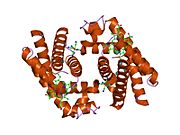Biology:Cytoglobin
 Generic protein structure example |
Cytoglobin is the protein product of CYGB, a human and mammalian gene.[1]
Cytoglobin is a globin molecule ubiquitously expressed in all tissues and most notably utilized in marine mammals. It was discovered in 2001[2] and named cytoglobin in 2002.[3] It is thought to protect against hypoxia. The predicted function of cytoglobin is the transfer of oxygen from arterial blood to the brain.[4]
Function
Cytoglobin is a ubiquitously expressed hexacoordinate hemoglobin that may facilitate diffusion of oxygen through tissues, scavenge nitric oxide or reactive oxygen species, or serve a protective function during oxidative stress.[1][5]
Applications
CYGB expression can be used as a specific marker with which hepatic stellate cells can be distinguished from portal myofibroblasts in the damaged human liver.[6]
References
- ↑ 1.0 1.1 "Entrez Gene: CYGB cytoglobin". https://www.ncbi.nlm.nih.gov/sites/entrez?Db=gene&Cmd=ShowDetailView&TermToSearch=114757.
- ↑ "Characterization of a stellate cell activation-associated protein (STAP) with peroxidase activity found in rat hepatic stellate cells". The Journal of Biological Chemistry 276 (27): 25318–23. Jul 2001. doi:10.1074/jbc.M102630200. PMID 11320098.
- ↑ "Cytoglobin: a novel globin type ubiquitously expressed in vertebrate tissues". Molecular Biology and Evolution 19 (4): 416–21. Apr 2002. doi:10.1093/oxfordjournals.molbev.a004096. PMID 11919282.
- ↑ "Why Diving Marine Mammals Resist Brain Damage from Low Oxygen". ScienceDaily. 20 December 2007. https://www.sciencedaily.com/releases/2007/12/071218192033.htm.
- ↑ "A ubiquitously expressed human hexacoordinate hemoglobin". The Journal of Biological Chemistry 277 (22): 19538–45. May 2002. doi:10.1074/jbc.M201934200. PMID 11893755.
- ↑ "Cytoglobin is expressed in hepatic stellate cells, but not in myofibroblasts, in normal and fibrotic human liver". Laboratory Investigation 94 (2): 192–207. Feb 2014. doi:10.1038/labinvest.2013.135. PMID 24296877.
Further reading
- "Characterization of a stellate cell activation-associated protein (STAP) with peroxidase activity found in rat hepatic stellate cells". The Journal of Biological Chemistry 276 (27): 25318–23. Jul 2001. doi:10.1074/jbc.M102630200. PMID 11320098.
- "Cytoglobin: a novel globin type ubiquitously expressed in vertebrate tissues". Molecular Biology and Evolution 19 (4): 416–21. Apr 2002. doi:10.1093/oxfordjournals.molbev.a004096. PMID 11919282.
- "Characterization of human stellate cell activation-associated protein and its expression in human liver". Biochimica et Biophysica Acta (BBA) - Gene Structure and Expression 1577 (3): 471–5. Sep 2002. doi:10.1016/s0167-4781(02)00477-3. PMID 12359339.
- "Characterization of the heme environmental structure of cytoglobin, a fourth globin in humans". Biochemistry 42 (17): 5133–42. May 2003. doi:10.1021/bi027067e. PMID 12718557.
- "A globin in the nucleus!". The Journal of Biological Chemistry 278 (33): 30417–20. Aug 2003. doi:10.1074/jbc.C300203200. PMID 12796507.
- "The redox state of the cell regulates the ligand binding affinity of human neuroglobin and cytoglobin". The Journal of Biological Chemistry 278 (51): 51713–21. Dec 2003. doi:10.1074/jbc.M309396200. PMID 14530264.
- "Cytoglobin is a respiratory protein in connective tissue and neurons, which is up-regulated by hypoxia". The Journal of Biological Chemistry 279 (9): 8063–9. Feb 2004. doi:10.1074/jbc.M310540200. PMID 14660570.
- "Genomic organization and mutation analysis of three candidate genes for hereditary neuralgic amyotrophy". Muscle & Nerve 29 (4): 601–4. Apr 2004. doi:10.1002/mus.20009. PMID 15052627.
- "Crystal structure of cytoglobin: the fourth globin type discovered in man displays heme hexa-coordination". Journal of Molecular Biology 336 (4): 917–27. Feb 2004. doi:10.1016/j.jmb.2003.12.063. PMID 15095869.
- "Structural basis of human cytoglobin for ligand binding". Journal of Molecular Biology 339 (4): 873–85. Jun 2004. doi:10.1016/j.jmb.2004.04.024. PMID 15165856.
- "Allosteric regulation and temperature dependence of oxygen binding in human neuroglobin and cytoglobin. Molecular mechanisms and physiological significance". The Journal of Biological Chemistry 279 (43): 44417–26. Oct 2004. doi:10.1074/jbc.M407126200. PMID 15299006.
- "Hyperthermal stability of neuroglobin and cytoglobin". The FEBS Journal 272 (8): 2076–84. Apr 2005. doi:10.1111/j.1742-4658.2005.04635.x. PMID 15819897.
- "Structural characterization of the proximal and distal histidine environment of cytoglobin and neuroglobin". Biochemistry 44 (40): 13257–65. Oct 2005. doi:10.1021/bi050997o. PMID 16201751.
- "Promoter methylation of P16, RARbeta, E-cadherin, cyclin A1 and cytoglobin in oral cancer: quantitative evaluation using pyrosequencing". British Journal of Cancer 94 (4): 561–8. Feb 2006. doi:10.1038/sj.bjc.6602972. PMID 16449996.
- "Down-regulation of the cytoglobin gene, located on 17q25, in tylosis with oesophageal cancer (TOC): evidence for trans-allele repression". Human Molecular Genetics 15 (8): 1271–7. Apr 2006. doi:10.1093/hmg/ddl042. PMID 16510494.
- "Frequent genetic and epigenetic abnormalities contribute to the deregulation of cytoglobin in non-small cell lung cancer". Human Molecular Genetics 15 (13): 2038–44. Jul 2006. doi:10.1093/hmg/ddl128. PMID 16698880.
External links
- cytoglobin at the US National Library of Medicine Medical Subject Headings (MeSH)
 |








